FIG 2 .
zapE inactivation leads to a stress-dependent (anaerobiosis, temperature) elongated phenotype of E. coli. zapE encodes an ATPase. (A) Anaerobiosis-dependent phenotype of E. coli wild-type, ΔzapE mutant, and complemented strains. Growth of K-12, K12::ΔzapE, and K12::ΔzapE/pzapE-GFP strains in minimum media in the presence (+O2) or absence (−O2) of oxygen at 37°C is shown. Scale bars are 10 µm. Arrows indicate elongated bacteria. (B) Temperature-dependent phenotype of K-12, K12::ΔzapE, and K12::ΔzapE/pzapE-GFP strains. Bacteria were grown in rich media at the indicated temperature until an OD600 = 0.5 was reached. Scale bars are 10 µm. Arrows indicate elongated bacteria. **, P < 0.01; *, P < 0.05. (C) ZapE or ZapEK84A ATPase activity assessed by silica layer chromatography. The reaction was performed in a Tris-HCl buffer (50 mM; pH 7.4) containing 10 mCi of radiolabeled ATPγ32 (or GTPγ32), 10 mM ATP, and 2.5 mM MgCl2 in the presence of various ZapE-H6 or ZapEK84A-H6 quantities, as indicated. (D) Most probable atom model of 15 DAMMIN reconstructions fitting the data at up to smax = 0.24 Å − 1 with an x = 1.683 and an NSD value of 0.7 ± 0.024, indicating the stability of the solution. The Walker A motif in the AAA+ ATPase is highlighted in yellow. N-terminal and C-terminal residues of ZapE are highlighted in green and blue.

